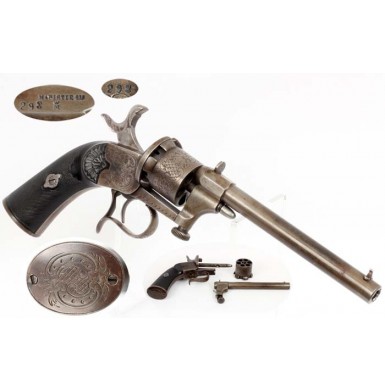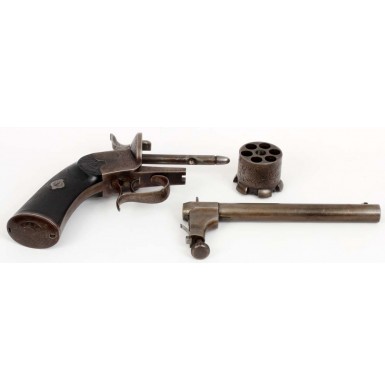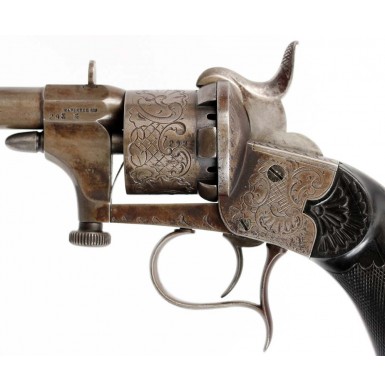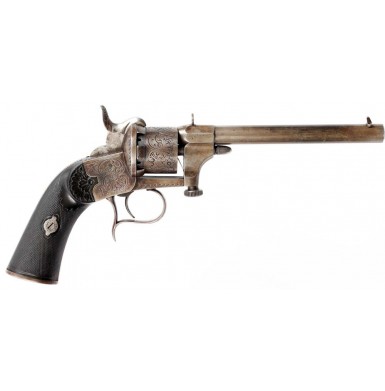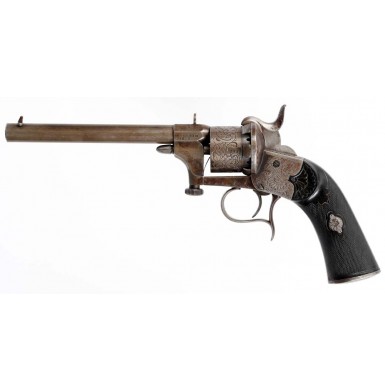This is a wonderful example of a very scarce Mariett” Brevette (Patent) Pinfire Revolver. Gilles Mariett” was a prominent Li’ge based gunmaker who worked from 1832 to 1865. Mariett” received more than 20 arms patents during his career and is probably as responsible as Casimir Lefaucheux (the inventory of the pinfire system) for the successful evolution and development of pinfire handguns. Lefaucheux had concentrated on refining his pinfire system within the design confines of the shotgun, but Mariett” saw the potential to incorporate the pinfire cartridge into a successful handgun design. His initial efforts were to design and market under hammer, ring trigger pepperboxes. Mariett’s designs greatly influenced Lefaucheux, who displayed a pepperbox at the 1851 London Exhibition that drew heavily upon Mariett’s work. Mariett” also developed single and double action revolvers that utilized the pinfire system. Rather than using the hinged loading gate and ejector rod found on the M-1854 revolver designed by Eugene Lefaucheux (Casimir’s son), Mariett’s design involved the disassembly of the pistol for loading and unloading. His system allowed the pistol to be easily broken down into three major components; the barrel, the cylinder and the frame. A long, heavy arbor pin projected from the recoil shield at the rear of the frame and passed through center of the cylinder. The barrel assemble was secured to the arbor pin via a heavy screw, which engaged a detent in the bottom of the arbor pin. A large thumbscrew on the bottom of the barrel lug allowed the screw to be easily tightened or loosened, as required. Once the barrel assembly was removed, the cylinder could be easily slid off the arbor pin to allow the insertion of fresh cartridges in the chambers, or the arbor pin could be used to eject the spent cartridges from the chambers. Although the system was simple and easy to use, it was probably not successful from a military standpoint because of its very simplicity. Disassembly of a firearm during the stress of battle was probably not the best way to load or unload a firearm.
This Mariett” Brevette (Patent) Pinfire Revolver is in NEAR FINE condition. The gun is 100% complete, correct and original in every way. The pistol is a 6 shot, 9mm pinfire with a single action lockwork and a 6 1/8” round barrel. The left side of the barrel lug is marked in two lines: MARIETT” BTE / 293 (CROWN) M. The first line indicates that the pistol is of Mariett’s patent design, and the second line shows that the pistol is serial number 293 and is marked with Mariett’s Crown/M trademark. The serial number 293 also appears on the left side of the grip frame, under the grips, and on the cylinder. IN addition to the serial number, these same components are marked with the assembly mating mark | |, as are the interior surfaces of the grips. The cylinder is also marked with an E / LG / * within an oval, which was the definite Li’ge proof mark from February 1811 through July 1893. The cylinder is also marked with an additional (CROWN) / T proof mark. The action of the pistol works well on all positions, and the cylinder times and indexes as it should, and locks up securely. The frame and cylinder of the pistol both retain about 10% of their original blued finish, most of which is in the protected areas and recesses. The balance of the frame and cylinder have a medium bluish-gray patina. The metal is mostly smooth, with only some scattered areas of minor pinpricking, mostly the front and rear edges of the cylinder. The frame and cylinder are both engraved with a loose foliate pattern that is simple, but attractive. The triggerguard is also engrave in the same fashion as the frame and has a hooked finger rest at its rear. The butt cap of the frame is engraved in the same pattern. The round barrel retains only traces of its blued finish, and show the same smooth, bluish-gray patina noted on the majority of the frame and cylinder. The bore of the pistol rates about FINE, and retains excellent rifling. The bore is mostly bright and shows only the most minor pinpricking and frosting within the grooves. The Mariett” patent tension screw is in place and securely joins the frame and barrel with no wobble or play. It also loosens easily to allow quick disassembly. The pistol retains its original dovetailed rear sight on the top of the barrel, near the frame junction, and the original dovetailed front sight as well. The two-piece ebony grips are in about VERY GOOD condition. The grips are assembly marked to the gun with a pair of file slash marks on their interior. The grips are carved with a lovely French-style shell motif at the grip to frame juncture, with the majority of the remaining grip area being finely checkered. The checkering shows some light wear and minor flattening. The grips show minor wear and light handling marks, but have no missing chips or gouges. The only condition issue to note is that the left grip panel has cracked along its length and has been repaired. The crack is tight, completely stable and follows the grain, making it barely noticeable. It does not materially detract from the display of the revolver, but is mentioned for exactness regarding the condition of the revolver.
Overall this is a really great looking and wonderful displaying example of a scarce pinfire variant revolver. Mariett” patent revolvers are always very well made, are typically very attractive and are highly desirable additions to arms collections. This is a great example of his work and is from the Civil War era, making it a potential commercial import to this country during that war. While it is unlikely that this gun saw military service, a wealthy civilian in either the north or south could have owned it. There is always the possibility (however unlikely) that it was the personal firearm of an officer on either side. At least one Mariett” pinfire revolver is known with strong Confederate provenance. The Richard D. Steuart collection contains a Mariett” revolver that was owned by Captain Clement Sulivane, who is credited as being the last Confederate officer to abandon Richmond when it fell. Sulivane subsequently wrote a book about the fall of Richmond. Sulivane's Mariett” is now in the collection of the Virginia Historical Society, and the gun is also pictured in the seminal work by Fuller & Steuart Firearms of the Confederacy.One way or another, it is a very high quality and very scarce example of a variant on Lefaucheux’s pinfire designs, by the gun maker who probably influenced Lefaucheux more than anyone else when it comes to revolver designs.
Provenance: ex Chris Curtis Collection - author of "System Lefaucheux" ON HOLD
Tags: Mariett

